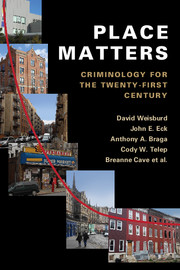Book contents
- Frontmatter
- Contents
- List of figures
- List of tables
- List of contributors
- Preface
- 1 Crime Places within Criminological Thought
- 2 The Concentration of Crime at Place
- 3 Theories of Crime and Place
- 4 The Importance of Place in Mainstream Criminology and Related Fields: Influences and Lessons to be Learned
- 5 Methods of Place-Based Research
- 6 Reducing Crime at High-Crime Places: Practice and Evidence
- 7 Crime Places in the Criminological Imagination
- Notes
- References
- Index
1 - Crime Places within Criminological Thought
Published online by Cambridge University Press: 05 April 2016
- Frontmatter
- Contents
- List of figures
- List of tables
- List of contributors
- Preface
- 1 Crime Places within Criminological Thought
- 2 The Concentration of Crime at Place
- 3 Theories of Crime and Place
- 4 The Importance of Place in Mainstream Criminology and Related Fields: Influences and Lessons to be Learned
- 5 Methods of Place-Based Research
- 6 Reducing Crime at High-Crime Places: Practice and Evidence
- 7 Crime Places in the Criminological Imagination
- Notes
- References
- Index
Summary
A new perspective in criminology has emerged over the last three decades, a perspective with considerable potential to add to our understanding and control of crime. In the same way the invention of the microscope opened up a biological world scientists had not previously seen, this new perspective opens the world of small geographic features we had overlooked. Research has demonstrated that actions at these microplaces have strong connections to crime. Just as the microscope paved the way to new treatments and advances in public health, this new perspective in criminology is yielding improved ways of reducing crime. This new perspective shifts our attention from large geographic units, such as neighborhoods, to small units, such as street segments and addresses. This shift in the “units of analysis” transforms our understanding of the crime problem and what we can do about it.
There are two aspects to this shift in units. The first shifts our attention from large geographic units to small ones. This we have just mentioned. The second shifts our attention from people to events, from those who commit crimes to the crimes themselves. Criminology has been primarily focused on people (Brantingham and Brantingham 1990; Weisburd 2002). Frank Cullen (2011) noted in his Sutherland Address to the American Society of Criminology in 2010 that the focus of criminology has been even more specific. He argued that criminology was dominated by a paradigm, which he termed “adolescence-limited criminology,” that had focused primarily on adolescents.
To what extent have person-based studies dominated criminology? Weisburd (2015a) examined units of analysis in all empirical articles published in Criminology between 1990 and 2014. Criminology is the highest-impact journal in the field and the main scientific publication of the largest criminological society in the world, the American Society of Criminology. He identified 719 research articles. Of the 719 articles, two-thirds focused on people as units of analysis. The next main units of study were situations (15 percent) and macrogeographic areas such as cities and states (11 percent). Eck and Eck (2012) examined the 148 research papers published in Criminology and Public Policy from its first issue in 2001 until the end of 2010, and the 230 articles published in Criminal Justice Policy Review during the same time period.
- Type
- Chapter
- Information
- Place MattersCriminology for the Twenty-First Century, pp. 1 - 15Publisher: Cambridge University PressPrint publication year: 2016



